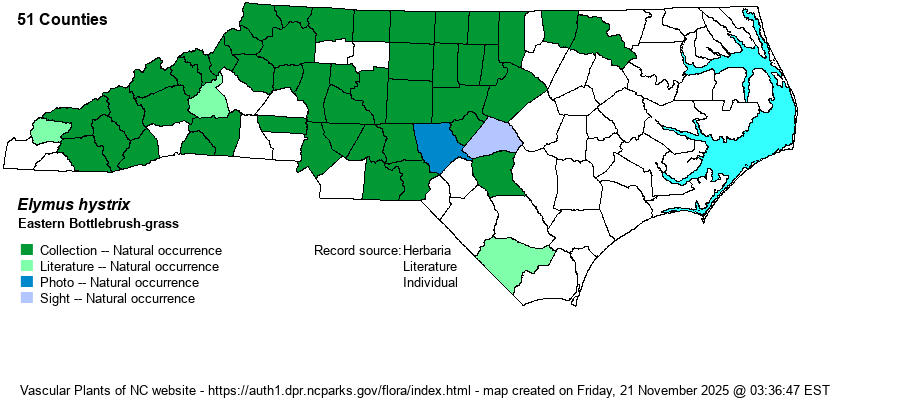| Author | L. | |
| Distribution | Mountains and Piedmont; absent from the Sandhills proper. In the Coastal Plain it extends down the Cape Fear River and the Roanoke River on adjacent mesic slopes. A specimen from New Hanover County (Silveus 5989 TAES) has no image attached and needs vetting.
N.B. to Man., south to GA and OK. | |
| Abundance | Frequent to common over nearly all of the Mountains and Piedmont; oddly few collections from the southwestern Piedmont and far southwestern Mountains. This species is recommended to be State Ranked as S5, instead of S4. | |
| Habitat | Mesic to moist hardwood forests and mixed pine-hardwoods, northern hardwoods. Prefers circumneutral to basic, nutrient-rich soils. Usually avoids floodplain forests and levees, occurring upslope. |
| Phenology | Flowering and fruiting July-September. | |
| Identification | Compared with our other wild-ryes, Eastern Bottlebrush-grass has wider-spreading spikelets -- often horizontally (perpendicular to the axis of the inflorescence) and generally fewer spikelets per inflorescence. The inflorescences begin erect but most eventually arch outwards. Technically, the glumes have 0-1 veins (vs. 2-5 veins in our other wild-ryes). This is a beautiful grass! | |
| Taxonomic Comments | This species was originally placed in the genus Hystrix -- in RAB (1968) as H. patula, and in some older references as H. hystrix. Weakley (2020) lists three varieties in the state, but the website editors do not consider them well enough described (and specimens not annotated) to be useful to field biologists.
Ryegrasses or Wild-ryes (genus Elymus) are noted by their evenly spaced leaves and elongate, terminal inflorescence that recall cultivated rye or wheat. Each floret produces several long, skinny awns (shortest in E. virginicus sensu stricto). Identification of some species requires a dissecting scope or at least a 10x handlens. | |
| Other Common Name(s) | Often known just as Bottlebrush Grass. | |
| State Rank | S4 [S5] | |
| Global Rank | G5 | |
| State Status | | |
| US Status | | |
| USACE-agcp | UPL link |
| USACE-emp | UPL link |

